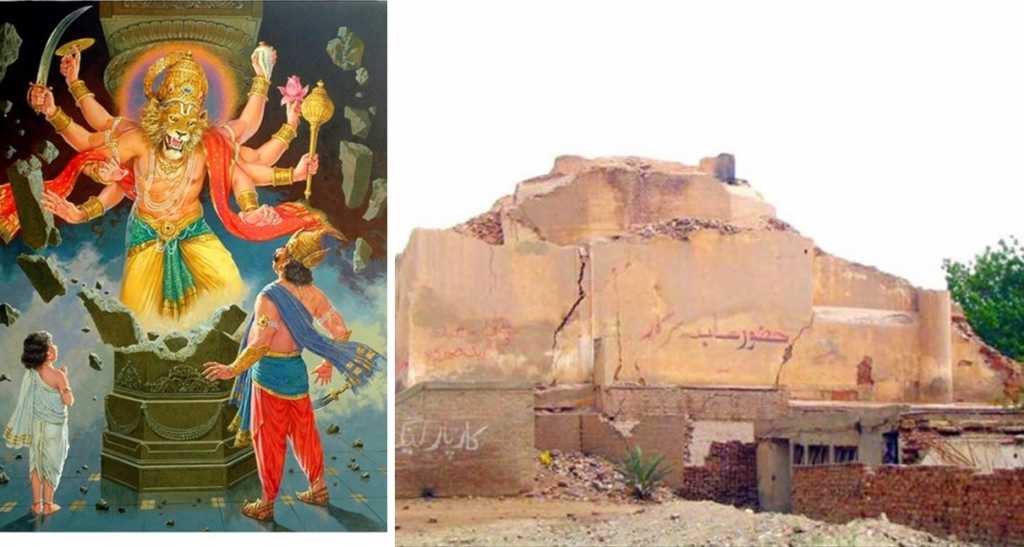The demon King Hiranyakashipu despised Lord Vishnu. He prayed before Lord Brahma to grant him powers which would help him destroy Vishnu. Pleased by his devotion and tapasya, Lord Brahma granted Hiranyakashipu a boon. Hiranyakashipu would not not die within any residence or outside any residence, during the daytime or at night, nor on the ground or in the sky. His death would not be brought about by any weapon, nor by any human being or animal. He would not meet death from any entity, living or non-living created by Lord Brahma. He would not be killed by any demigod or demon or by any great snake from the lower planets. Thus blessed, Hiranyakashipu set about erasing the worship of Lord Vishnu from his domains.
Hiranyakashipu’s son Prahlad, though was a devotee of Lord Vishnu. Prahlad, going against his father’s wishes claims that Lord Vishnu is the supreme Lord of the world, all pervading and omnipresent. This arouses Hiranyakashipu’s ire, who mocks Prahlad by asking if Lord Vishnu was present in the pillar in front of him. Prahlad responds saying that Lord Vishnu was, is and will always be. Enraged at his response, Hiranyakashipu proceeds to smash the pillar with his mace. And lo and behold, Lord Narasimha emerges from the shattered pillar and devours Hiranyakashipu. Lord Vishnu, in the form of Narasimha is neither man nor animal. He devours Hiranyakashipu at twilight, when it is neither day nor night.
Hiranyakashipu is disembowelled on Lord Narasimha’s thighs, which are neither ground, nor sky. He is killed by Lord Narasimha’s sharp claws, that are not weapons. Thus, Lord Vishnu ensured Dharma was protected without breaking Lord Brahma’s boon.
It is believed that Prahlad, thus saved by Lord Vishnu remained his devotee for the rest of his life. He is believed to have constructed Prahladpuri Temple on the site where Narasimha, Lord Vishnu’s fourth avatar made his appearance. The Prahladpuri temple at Multan, Pakistan was believed to be a wonder, with pillars of gold.
For unknown reasons, the original Prahladpuri Temple is believed to have sunk into the ground and another temple is believed to have been constructed over the original structure. This arrangement is believed to have continued for centuries when Arabs invaded and occupied Multan. Prahladpuri Temple was desecrated and reduced to insignificance by the 19th century. By this time a tomb of Hazrat Zakariya was constructed next to the temple and a mosque was built up in its vicinity subsequently.
In 1861, public donations led to another temple being constructed on the site. In 1881, there were riots between Hindus and Muslims on the height of the Shikharas of the temple and while the temple was gutted, it was rebuilt. Partition of India and the subsequent flight of the Hindu community meant that Prahladpuri Temple soon fell into disrepair. The moorti of Lord Narasimha was taken to Haridwar. Even in 1992, on the eve of Babri Masjid demolition, Prahladpuri temple was believed to be a prominent landmark of the city. In the aftermath of the riots that the demolition of Babri Masjid spawned, the temple was destroyed once again. In 2006, it was decided that the temple premises would be used by pilgrims to the tomb of Hazrat Zakariya to wash and cleanse themselves. Last heard, the temple had been reduced to a garbage dump.
Such is the fate of the land where the fourth avatar of Lord Vishnu made his appearance on earth to protect his devotees. From being a magnificent temple to the majesty of Lord Narasimha, to being reduced to a garbage dump. From Kamrup to Baluchistan, from Kashmir to the southern tip of Kerala, there are hundreds, perhaps even thousands of pieces of our heritage, temples, ashrams, samadhis, moortis that have been desecrated, ruined and demolished. This is what centuries of invasions, conquests, defeats and in-fighting have reduced Indian cultural heritage to. It is India’s tragedy that its people have long turned apathetic to India’s cultural heritage.
